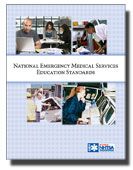 |
Related Resource: |
The National Highway Traffic Safety Administration has recently released the National EMS Education Standards, a set of guidelines that establish minimum educational competencies for entry-level EMS providers. This marks the next step in implementing the EMS Education Agenda for the Future; a Systems Approach.
The EMS Education Agenda was released in 2000 and it has been guiding the progress of EMS toward an education system based upon five components:
- the National EMS Core Content (2004)
- National EMS Scope of Practice Model (2006)
- National EMS Education Standards (2009)
- National EMS Certification (to be released)
- National EMS Program Accreditation (to be released)
The Standards replace the National Standard Curricula, which have been the backbone of EMS training for years, and support the ongoing transition from a limited focus on training to a more complete educational perspective.
Let’s take a moment to look at exactly what the Standards are, why they are important, and how it will impact both EMS providers and the profession as a whole.
What are the National EMS Education Standards?
“(The Standards) define the competencies, clinical behaviors, and judgments that must be met by entry-level EMS personnel to meet practice guidelines defined in the National EMS Scope of Practice Model.” (NHTSA p. 7)
There are four certification levels: emergency medical responder (EMR), emergency medical technician (EMT), advanced EMT (AEMT), and paramedic. The Standards are built upon the premise that each certification level is part of a sequence that culminates in paramedic certification. Each certification level is built upon the knowledge, skills and competencies of the lower levels. Thus, an EMT must meet all of the competencies of an EMR, as well as those specific to the EMT. Likewise, a paramedic must meet all of the competencies of an EMR, EMT, AEMT, as well as those specified for entry-level paramedics.
The Standards are made up of four components: competencies, knowledge required to achieve the competencies, clinical behaviors/judgments, and educational infrastructure. They provide a general framework to support individual programs for developing specific curricula to meet identified training and educational needs in particular regions. The format also allows for ongoing revision when research supports practice changes based on scientific evidence or when standards of care change.
The NHTSA also published instructor guides for each certification level. These include the basic information that programs must deliver in order for their students to meet the described competencies. The guides will serve as the foundations for textbooks and lesson plans. It is important to note that programs will need more than just the instructor guides to deliver a complete program.
Why Are the Standards Important?
The most important aspect of the Standards is the fact that they move EMS, paramedics in particular, one step further along the road to professionalization. The EMS Education Agenda process in general and the Standards in particular are together raising the bar for EMS practitioners. Just as practitioners progress from level to level, so does the discipline progress from a training to an educational perspective. As a consequence of this, many of the individuals who teach EMS will have to become more than simply certified instructors; they will have to become educators.
EMS educators will need to possess a foundation in educational methodology; adult learning theory; curriculum and lesson plan design and development; as well as evaluation, assessment, analysis and communication skills. Our EMS educators must be well-prepared for the transition; education is more than simply training. This change in perspective will make our practitioners better at what they do, and ultimately, will lead to better patient care.
What Will the Standards Mean to Us?
At first glance, it may appear the Standards will have little impact on current practitioners. The Standards solidify the four certification levels so that each level will have a common set of minimum, entry-level competencies across the country. It means that those who learned initial assessment and the four different pathways of secondary assessment may not recognize the concept of “primary and secondary” assessments. For the old school folks like me, it means a return to familiar terminology.
For those who hope to become paramedics, it means that you will need to know more information at a greater depth and breadth. Paramedic programs may include such course work as ethics, special operations, incident management, leadership, as well as more in-depth pathophysiology cardiology and pharmacology. Practitioners will learn much more about the “why” we do what we do.
As a result of more formal education, I predict that paramedics will eventually be recognized as a more independent practitioner, rather than one who simply collects data, reports the findings, and follows a physician’s orders. Practitioners will then be better prepared to practice in the field.
The biggest impact the Standards will have on current and future paramedics is that many will receive college credits and Associate’s Degrees in the process of achieving paramedic certification (some will even attain Bachelor’s Degrees). This increased standard level of education will make it more challenging for the “dinosaurs” to keep up with the “young Turks.”
The Future
As we move toward achieving the last two components of the EMS education agenda -- national EMS certification and national accreditation of EMS programs -- we may see some resistance. Some states have two or more levels of certification between EMT and paramedic. They may choose not to comply with the Scope of Practice Model. Some places may see the need to add advanced practice paramedics, such as in Wake County, NC. Some states currently do not accept or recognize the National Registry of EMTs, which may pose barriers to national certification. Some training programs may not be able to meet the national accreditation requirements and may cease to exist.
Even considering all of the potential barriers, the goal of the EMS education agenda and EMS practitioners is, and must always be, continually improving the care we provide for the people who call for our help. Much has changed since 1967, when Dr. Frank Pantridge’s paper lead to the development of mobile cardiac care units and his invention of the portable defibrillator. It’s time for our educational programs to catch up with our practice. It’s time for program graduates to be more “work ready,” and better prepared to be prehospital practitioners who have a stronger understanding of why they do what they do. The Standards provide one more step toward that destination.
| Author’s note: You can find and download the National EMS Education Standards document, along with the Instructor Guides for each of the four national certification level at: http://www.EMS.gov. Move your cursor over Education, the third choice in the red menu bar at the top, and click on “National EMS Education Standards” near the bottom of the popup list. |
References
National Highway Traffic Safety Administration (2009). The National EMS Education Standards. Retrieved February 4, 2009 from http://www.nhtsa.gov/staticfiles/DOT/NHTSA/ems/811077a.pdf


